We check the cylinder block during a major overhaul of the engine.
The block is checked and measured to ensure reuse.
The engine cylinders are made as a single unit, without the use of liners.
If damaged or worn, the cylinders are not repaired.
Before removing the pistons with connecting rods, we measure the protrusion of each piston.
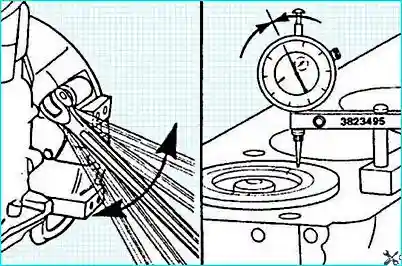
By measuring the piston protrusion, you can determine the possibility of grinding the upper surface of the cylinder block, if necessary.
We remove the engine, as indicated in the article - Removing and installing the Cummins ISF2.8 engine
Disassembling the engine
Initial inspection
Before cleaning or further disassembling the cylinder block, inspect it, checking for damage (cracks, traces of abrasion, etc.), which may exclude the possibility of its reuse.

Pay special attention to the following items:
- - main bearing caps and beds;
- - cylinders;
- - upper plane of the cylinder block;
- - water pump inlet mounting surface;
- - gasket surfaces in the front and rear of the cylinder block.
Cleaning and checking the usability of the block
Check all plugs for signs of damage or leaks.
If it is necessary to thoroughly clean the cylinder block before reuse due to a large number of foreign particles or contamination, remove all relevant plugs.
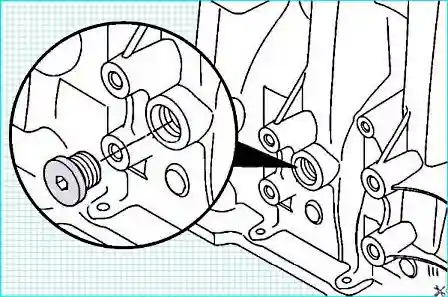
Make sure that all channels of the lubrication and cooling systems are clean.

With a brush with non-metallic bristles and a clean solvent clean the lubrication holes in the cylinder block.

Thoroughly clean all sealing surfaces from the remains of the old gasket.

Remove the block from stand
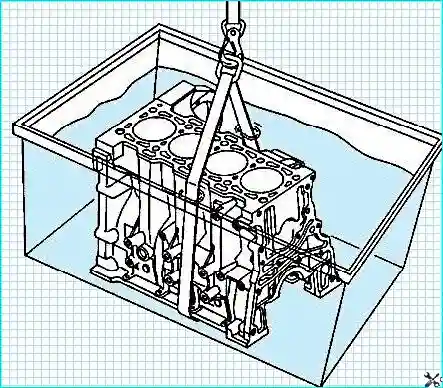
Cleaning the cylinder block in a flushing tank
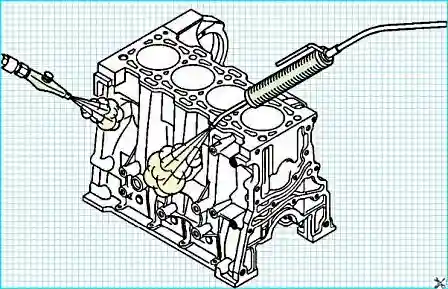
Removing the cylinder block from the flushing tank. Clean the cylinder block with steam and dry with compressed air.
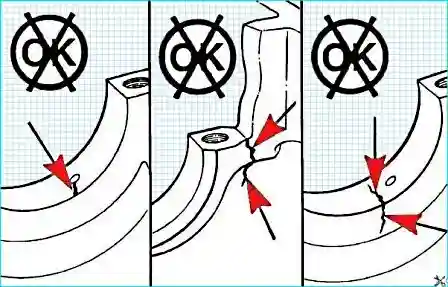
After cleaning the cylinder block, recheck it for signs of cracks, abrasion, and discoloration that would preclude its reuse.
Use the crack detection kit (part number 3375432) to detect cracks.
Pay special attention to the following items:
- - main bearing caps and beds;
- - cylinders;
- - upper plane of the block cylinders;
- - water pump inlet mounting surface;
- - gasket surfaces at the front and rear of the cylinder block.
Check all threaded bolt holes for thread damage.
Threaded holes can be repaired using bushings.
The following bushing repair kits are available:

- - Part number 3377905 - for American standard threads
- - Part number 3377903 for metric threads.
The bushings cannot be used to repair threaded holes for main bearing cap bolts. If they are damaged, the cylinder block must be replaced.
Check the cylinder surface for glossy areas.

Crossing lines should be visible on the cylinder surface, running at an angle of 20 - 25 degrees relative to the upper plane of the cylinder block.
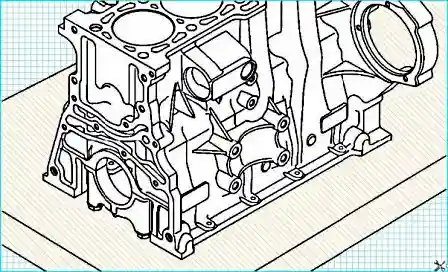
All measurements of the cylinder block must be taken when it lies on a flat surface with the main bearing caps installed.
If the cylinder block is on a stand and/or the main bearing caps are not installed, the measurements may be inaccurate due to deformation. (This applies to cylinder diameters, main bearing holes, etc.).
We install the main bearing caps without liners. Tighten the main bearing bolts.
Tightening torque – 80 Nm.
Main bearing bed diameter:
- - journals 1 and 5 - 79.982 –3.1489 – 80.008 +3.1499 mm;
- - journals 2, 3 and 4 – 79.977 -3.1487 – 80.013 +3.1501 mm.

If the diameters of the main bearing beds do not correspond to the standard, check the correct installation and orientation of the main bearing caps.
If the main bearing caps are installed correctly, the cylinder block must be replaced.
We measure the length of the main bearing bolts, for possible use during assembly.
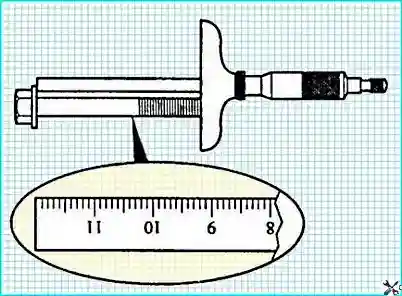
The length of the main bearing bolt rod should be no more than - 119.25 +4.695 mm
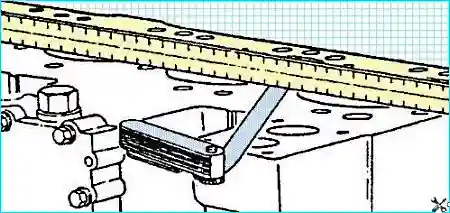
Check the cylinder block for flatness using a precision ruler and feeler gauge.
Maximum flatness:
- - 0.075 +0.0030 – 0.010 +0.0004 mm, within a 50 mm radius zone.
Check for minor irregularities or defects. If present, the top surface of the cylinder block must be ground.
Grinding the top surface of the cylinder block is only permitted if the required piston protrusion height can be achieved after this.
The use of repair linings after grinding the top surface of the cylinder block is not provided.
If the required piston protrusion height cannot be achieved after such grinding, the cylinder block must be replaced.
The cylinder diameter is measured at a distance of more than 50 mm (1.97 in) from the top surface of the cylinder block to avoid loss of measurement accuracy.
When measuring, matting or boring cylinders, all main bearing caps must be secured with bolts tightened to the required tightening torque.
Check the cylinder surface for damage or excessive wear.
Using a dial bore gauge (part number 3376619) measure the cylinder diameter at 4 points spaced 90 degrees apart at the extreme positions of the piston stroke.
- Bore diameter: 93.99 -3.7004 – 94.01 +3.7012 mm;
- Deviation from roundness: 0.01 +0.0004 mm;
- Taper: 0.01 +0.0004 mm.
Block repair
Before repairing the cylinders, it is necessary to close the oil channels and holes for the tappets in the upper part of the cylinder block with waterproof tape.
Matting the cylinder surface:

Matting provides the surface quality necessary for the normal operation of the piston rings.
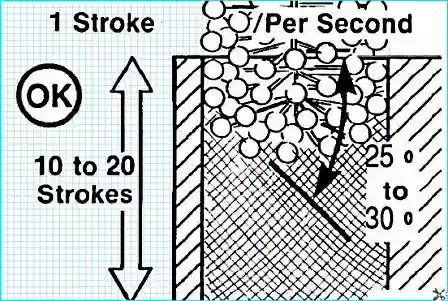
Matting is only allowed if the cylinder dimensions are still within the norm.
The fit of new piston rings in cylinders with a glossy surface will not be tight.
Use a round honing head (Catalog No. 3823612) or similar with a rotation speed of 300 - 400 rpm, making one cycle of movement in the vertical direction per second.
Use high-quality honing oil or a mixture of different proportions of SAE 30W and diesel fuel.
The vertical passes should be smooth and continuous along the entire height of the cylinder.
Check the cylinder bore after 10 passes.
The angle of the intersecting lines depends on the rotational speed and the vertical movement speed of the honing head.
Too high or too low a movement speed will cause this angle to deviate from the norm.
On a properly matted surface of the cylinder, intersecting lines should be visible, running at an angle of 20 - 25 degrees relative to the upper plane of the cylinder block.
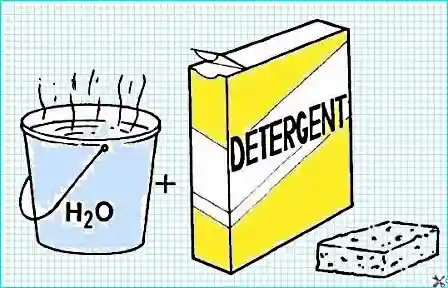
To remove gloss, use a concentrated solution of detergent in hot water to flush the cylinders.
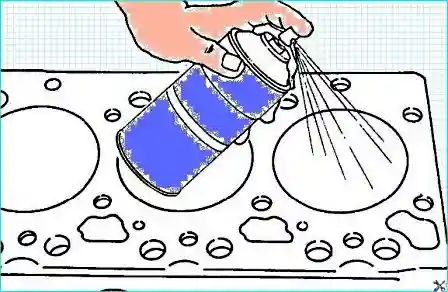
Clean the cylinders immediately after matting.
Failure to do so may result in engine failure.
Flush the cylinders until all of the cleaning agent is removed.
Dry the cylinder block with compressed air.
Check the cylinder surface for cleanliness, by wiping it with a piece of white lint-free cloth slightly moistened with oil.
If there is any abrasive material left, continue cleaning until it is completely removed.
Wash the cylinder surface with solvent. Dry the cylinder block with compressed air.
When replacing the cylinder block or using a cylinder block that was in storage, be sure to remove engine oil and preservative oil from the cylinder surfaces, gasket areas and main bearing beds before using it.





